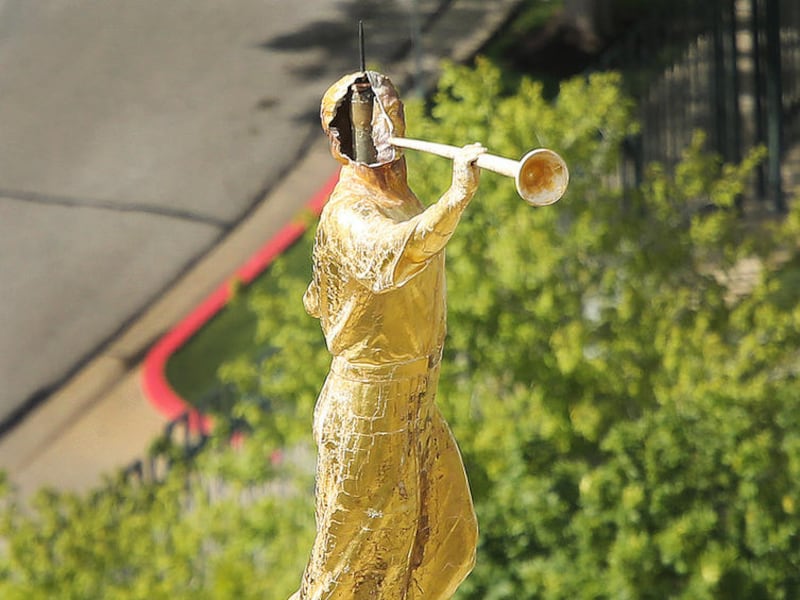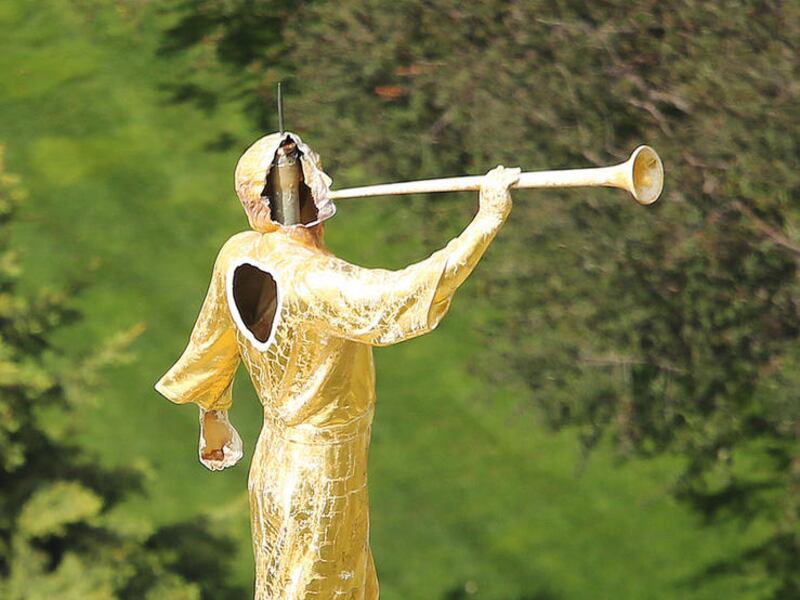BOUNTIFUL — Moroni was just doing his job.
The statue of the Book of Mormon prophet that rises high on a spire above the Bountiful Temple was struck by lightning Sunday afternoon, but that's one of his twin purposes.
Statues of the Angel Moroni on most temples of The Church of Jesus Christ of Latter-day Saints are more than symbolic landmarks. They also are equipped with lightning rods, which means they are designed to attract lightning strikes away from other parts of the faith's 150 operating temples around the world.
The first Moroni statues were bronze, copper or aluminum. The bronze figure on the Washington D. C. Temple, completed in 1974, weighs 4,000 pounds.
Today's statues are made of fiberglass and weigh about 300 pounds, according to an article in the church's New Era magazine. Then they are gilded with gold. The gold, again, does two jobs. It is striking to look at and is an iconic part of most temple, but it also is a perfect conductor of electricity.
With gold leaf, a place on top of a temple's highest spire and a copper lightning rod that extends out of the top of statue's head and is attached to a grounding cable below, the Angel Moroni makes a good target.
"The angel Moroni statues get hit by lightning all the time," Tyler Wilson, director of special projects at Okland Construction, told the Deseret News seven years ago when the statue on top of the Oquirrh Mountain Temple had to be replaced because of a lightning strike.
"There's a misunderstanding that such strikes are rare, but that's not the case at all," Wilson said.
Effective lightning rods are vital. Wilson said without a good grounding system, a lightning strike would damage a temple's electrical system and components and threaten the safety of those inside.
Most of the time, the lighting rods on the statues channel the energy of a strike through the grounding system. Other times, arcing strikes hit other parts of the statues. But the damage is relatively small and is difficult to see from ground level.
For example, when Okland Construction handled the renovation of the Washington D.C. Temple's spires several years ago, workers found repeated lightning strikes to the temple's angel Moroni statue had left damage "not visible to the naked eye, with strikes having left holes the size of a quarter," Wilson said.
The Bountiful Temple's Angel Moroni statue sustained obvious damage when lightning hit at 2:12 p.m. on Sunday. Photos show part of the statue's head missing and a hole in the back.
Moroni is revered by the LDS faithful as a prophet who wrote the final book in the Book of Mormon on the American continent several hundred years after Christ and who appeared as an angel to Joseph Smith several times in the 1820s.
The first temple with an Angel Moroni statue was the Salt Lake Temple, an internationally recognized symbol of the church that was dedicated in 1893.
The first LDS temple in Kirtland, Ohio, dedicated in 1836, had a spire with a weather vane. The Nauvoo Illinois Temple, dedicated in 1846, had a horizontal angel attached to a lightning rod in the form of a spire. That temple was destroyed by arson in 1848, a year after the Mormons left to move west to Utah, and tornado-level winds in 1850.
LDS Church President Wilford Woodruff asked Dallin sculptor Cyrus Dallin to create something for the temple's central spire. Dallin was not LDS, but he searched LDS scripture for inspiration and decided the Book of Mormon prophet Moroni was a good representation of the church's belief in the restoration of the gospel of Jesus Christ.
Today, 142 of the 150 temples have a Moroni statue. The statue depicts Moroni blowing a trumpet that symbolizes the spread of the gospel and the Savior's Second Coming. The Bible says Christ will come from the East, so the Angel Moroni statue on temples faces east when possible.
There are six versions of the statue. The versions used for new temples constructed today are usually 6 feet, 8 inches tall, but those on larger new temples can be 13 feet, 8 inches tall, such as Oquirrh Mountain's.
Lightning struck the tower of the St. George Utah Temple in 1878. The tower was rebuilt.
Lightning is not the only hazard facing the Angel Moroni. Earthquakes rotated the statues on the Tokyo Japan Temple in 2010 and the Cebu City Philippines Temple in 2013. An earthquake knocked the trumpet out of Moroni's hand on the Santiago Chile Temple in 2010.
Email: twalch@deseretnews.com







